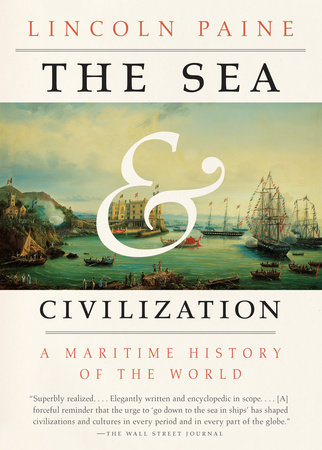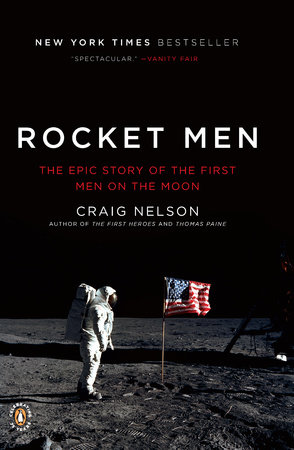A conversation with Lincoln Paine, author of
THE SEA AND CIVILIZATION
A Maritime History of the World
Q: THE SEA AND CIVILIZATION retells the last 3,500 years of civilization’s history through the lens of maritime travel, trade, and exploration; Felipe Fernández-Armesto calls it “the best maritime history of the world”! There are many books on the topic of maritime history—what sets yours apart?
A: One thing that distinguishes my book from a lot of other books about maritime history is that I didn’t approach the project with the idea that I wanted to prove anything. I started the book at what I took to be the useful beginning of the story and generally followed where the evidence led. The whole basis of the historian’s work is to make inquiries and ask questions. At the same time, as authors we are supposed to write with authority. The problem is that many people follow the trial lawyer’s dictum that you never ask a question unless you are sure of the answer. I have no problem asking questions to which I don’t have the answers. And the delight in researching and writing The Sea and Civilization came from discovering things about which I previously knew absolutely nothing and which have given me—and I hope my readers and other accomplices—new ways to understand the world.
Q: Often we think of sea exploration as a Western specialty—Phoenicians, Vikings, the Spanish Armada—but you also write about the seafaring societies of Africa and Asia. How was maritime trade and exploration formative in African and Asian societies?
A: I’m delighted that you include among westerners the Phoenicians, who lived on the coast of what are now Lebanon and Syria. But to answer your question, no one culture, race, nationality, religion, or linguistic group has a monopoly on maritime endeavor. Beyond that, until relatively recently, seafaring was of vastly greater importance to the people of North and East Africa and Asia from the Red Sea to the Yellow Sea than it ever was to non-Mediterranean Europe.
Seafaring was formative for Asia and Africa in any number of ways, but there are three especially significant examples. The first was the spread of Austronesian-speaking people from southern China through island Southeast Asia and east into the Pacific islands, which they began to reach about 3,500 years ago. Somewhat later than this, 2,000 years ago, a branch of Austronesian-speakers from Southeast Asia began sailing west across the Indian Ocean to Madagascar and the coast of Africa, to which they introduced three modern staples of sub-Saharan African cuisine: taro root, the water yam, and the banana. The last, and most obvious maritime transformation was the spread of religion—Hinduism and Buddhism eastward from India, and Islam south and east from the Arabian Peninsula.
Q: How did you go about your research? What did you discover that most surprised you?
A: I did a fair amount of reading, but the challenge wasn’t the reading itself so much as it was ferreting out the right things to read. I spent a lot of time in university libraries, including a week a month at Columbia for the better part of a year. In Maine I practically commuted to Bowdoin College for longer than that, and I availed myself of online services and the interlibrary loan program at the University of Southern Maine.
The single most surprising discovery in my research has to be the symbiotic relationship between commerce and religion, which is ancient, profound, and universal.
Q: You write, “I want to change the way you see the world.” Why is it so important to “let the earth tones fade” and shift our focus to the sea when we study world history?
A: It is very difficult—for me, anyway—to think about the progress of world history without taking stock of what happened on the oceans, seas, and rivers of the world. The lines of communication they fostered made long-distance cultural exchange not only possible but transformational. This is obvious in a host of scenarios, from the transplantation of Islam from the Arabian Peninsula and environs to South and Southeast Asia, to the transplantation of Spanish, Portuguese, and English culture—including language and different strains of Christianity—and of African culture, through the slave trade, to the Americas.
One thing I would like readers to take away from this book is the need to think actively about the environmental and cultural constraints on and benefits of maritime enterprise, and to think about terrestrial enterprise in the same terms. We seldom stop to consider what makes networks of people possible now or in the past. Since the development of trains, cars, and airplanes, we’ve lost sight of the fact that in many parts of the world, land transportation was just as seasonal as transport by sea, and even in the best of circumstances, infinitely less efficient in terms of cost, energy, and time.
Q: What are the significant moments in maritime history that we tend to overlook?
A: The problems of the Egyptian peasant Khunanup four thousand years ago are not, in and of themselves, terribly momentous. But his story illustrates an ordinary Egyptian’s familiarity with, and appreciation of, the importance of navigation to the well-being of all Egyptians, from the pharaoh down. At the same time, it offers the opportunity to discuss the almost universal metaphor of the ship of state in the millennia since then.
Similarly, the discussion of the ninth-century Scandinavian merchants Ohthere and Wulfstan lets me introduce, in the words of contemporaries, the idea that not all Scandinavians of the age fit the popular image of Vikings. Norse, Swedish, and Danish mariners could be every bit as thoughtful, inquisitive, and trade-oriented as many of their contemporaries in Europe and beyond (who in turn could be just as thuggish as Scandinavians).
Of more immediate relevance to us was the Dutch capture of the Portuguese ship Santa Catarina near modern Singapore. This could easily have been just another in an endless line of similar events except that it was the catalyst for Hugo Grotius’s treatise, The Free Sea. Grotius subverted Spanish and Portuguese claims to in essence divide the whole non-Christian world between them, and his arguments helped shape the concepts of sovereignty, property, and freedom of navigation that undergird modern international law.
So we could say that these are examples of moments we have tended to overlook. But as with any event, without context these vignettes constitute data, not history. And in reading history, we have to be mindful of the fact that all events need to be understood in context. It is not enough to say: I recognize Columbus and 1492. Two notes do not make a symphony.
Q: What are the differences between saltwater and inland navigation in shaping world history?
A: There are few things more deceptive on a map than the blue lines tracing the route of a river. Few people who don’t actually live on or near one, and some lakes, realize how difficult and expensive freshwater navigation is. In northern climates especially, rivers tend to be very seasonal. In winter they freeze; in spring they flood; and by the autumn their water levels have often fallen so low that they are too shallow to navigate. If the terrain they flow through is not relatively flat, they are often navigable only going downstream, if that. In short, they need a lot of human intervention to make and keep them useful.
While rivers were essential for the development of many ancient civilizations—the Nile in Africa, the Indus in Pakistan and India, the Yangzi and Yellow Rivers in China, and the Mississippi and Amazon in the Americas—it wasn’t until the Middle Ages that Europeans really began to harness what is the most intricate and (now) navigationally useful network of rivers on the planet. On the whole, though, outside of China, rivers and their related canal systems didn’t come into their own until the advent of steam propulsion in the nineteenth century, when markets in continental interiors were opened up to the rest of the world.
Q: In THE SEA AND CIVILIZATION, you show how advances in boatbuilding, technology, and navigation are constantly opening up new opportunities for sea travel. How do such developments affect the nature of global power and economic responsibility?
A: When speaking of global power, you’re really talking only about the past five hundred years or so. European mariners had definite technological advantages over Native Americans, but the conquest of the Americas had as much to do with infection as with ingenuity. Elsewhere the globalization of European power took far longer, and lasted far less time, than is generally assumed—no more than 250 years at the outside, and for many places barely a century. It is commonplace to speak of the end of the Soviet Union as the watershed moment of the period since World War II, but the collapse of European colonialism in the 1950s and ’60s was more significant for more people, and is proof positive that maritime technology and naval supremacy are not enough to guarantee global power.
The end of these maritime empires coincided with the rising phenomenon of decentralized maritime commercial power. In this new world order, shipbuilders, shipowners, ships’ crews, and ships customers all hailed from completely different parts of the world. This is one face of globalization, which is as ruthless as it is efficient. The prevailing dogma of globalization has made many aware of how events in one place affect those in another. But it also makes it difficult to forge consensus about what you call economic responsibility, which I take to include a consideration of the effects of economic dislocation and environmental degradation caused by the growth of economic efficiency.
Q: You write that the cruise ship industry, as well as yachting and boating, resulted in part from “shifts in attitudes toward the natural environment of the sea.” What do you mean by this?
A: For most of human history, most people seem to have viewed going to sea with great trepidation. This began to change in Europe in the seventeenth and eighteenth centuries. At this point, people had been regularly sailing long distances—transatlantic and from Europe around Africa to Asia—for two or three hundred years. Even if it didn’t engage huge numbers of people, long-distance voyaging was no longer seen as entirely strange. In England around this time there were two fundamental developments: the embrace of yachting by Charles II and James II and their retinues; and doctors’ discovery of the curative powers of saltwater, which was said to improve ones teeth, to cure asthma, cancer, deafness, and madness, and to revive marriages, among other things.
The subsequent development of mechanical propulsion and greater control over nature, at least at its most benign, made people more comfortable with the idea of going on the water for pleasure. Now, technological developments such as lighter materials, faster rigs, and so on have made ocean cruising and racing, white-water rafting, canoeing and kayaking that much more appealing to people seeking to escape the conformity of our technologically constrained environments ashore.
Q: THE SEA AND CIVILIZATION includes remarkable illustrations and maps throughout, which come from museums and archives all over the world. How did you decide upon these images? Do you have a favorite?
A: It’s hard to point to a favorite image, because each piece tells its own story in its own way. I hope that the captions do justice to the artists’ vision, even if in some cases we can never know who the artist is or what his or her intent might have been. The image that will most likely confound readers’ assumptions of the way the world works is the Noah’s Ark painted by the Muslim illustrator Miskin in about 1590. Most people steeped in the Judeo-Christian tradition will be surprised to learn that the Quran retells a version of Noah and the Flood. Then again, most readers from any of the Abrahamic faiths probably don’t know that the Noah story has its roots in the Mesopotamian story of Gilgamesh and is far older than Islam, Christianity, or Judaism.
While the portolans and engraved maps were fun to track down, one of the distinct pleasures was working with Rosemary Mosher on the seventeen beautiful, hand-drawn maps she made for the book. Even with the benefit of computers, atlases, and gazetteers, it was a real challenge to design maps that were legible, comprehensive, and aesthetically pleasing, and it gives one a real appreciation for the brilliant achievements of the cartographers of the past half millennium and more.
Q: By the end of your book, you’ve brought us up to the present day. What are the modern-day advantages and challenges to navigation?
A: Technological advances in ship design and navigation technology, including the ability to disseminate accurate information about the way the world looks and acts, have made going to sea far safer than it ever was. Among the unintended consequences to that is a certain complacency in our approach to the sea. For recreational boaters in particular (but not exclusively), there is a failure to realize that no amount of technology or money will ever tame the sea. Shipping magnates are also cavalier in their insistence on building ships whose capacity pushes shoreside infrastructure (and budgets) to the breaking point and whose loss can threaten financial and environmental ruin—though usually not for them. Another challenge is how we deal with crimes like piracy and human trafficking at sea, the policing of which is based on laws that are hopelessly out of date.
Q: You live in Portland, Maine, and have written a fair amount about the state’s maritime history. What are some of the most fascinating things we should know about the state’s nautical history?
A: Before Europeans got here, members of the Mi’kmaq, Maliseet, Passamaquoddy, Abenaki, and Penobscot nations routinely hunted seals, whales, and fish in the Gulf of Maine, which remains one of the most abundant marine ecosystems in the world, and they also traded between Nova Scotia and Cape Cod. Fish drew Europeans to the Gulf of Maine, but the English were keen on harvesting the native hundred-foot-tall white pine trees, which made excellent masts for warships.
Completion of Portland Head Light, at the entrance to the harbor, was authorized by the ninth piece of legislation passed by Congress, in 1790, and the first dedicated to a public works project. The government’s effort to ensure safe navigation was wildly successful, and between 1787 and 1795, the number of ships owned in Portland grew from maybe one or two to eighty.
During World War II, Bath Iron Works built more destroyers than all Japanese shipyards combined, while 30,000 men, women, and minorities employed in an emergency merchant shipbuilding program in South Portland turned out 30 Ocean-class and 274 Liberty ships between 1941 and 1945.
Q: What’s next for you?
A: I’ve been thinking a lot about rivers, so perhaps something along those blue lines.
FOR BOOKING INFORMATION:
Erica Hinsley / ehinsley@randomhouse.com / 212-572-2018














